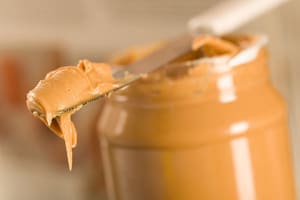 Flipping through some files on peanut butter production, I found, near the end of a U.S. Patent, a simple table:
Flipping through some files on peanut butter production, I found, near the end of a U.S. Patent, a simple table:
Standard Formula (by weight):
- Peanut butter: 90%
- Stabilizer 2%
- Salt 1.5%
- Sugar 6.5%
The stabilizer was the item of interest. A rabbi had walked into the office wanting to know whether an OU peanut butter company in Fitzgerald, Georgia could use its certified trailer to haul the peanut butter of other Georgia companies even though they were not kosher certified. I told him I don’t know. He said that his group leader told him that stabilizers in peanut butter can be a problem. I told him that I would look into it. In the course of doing so I learned something of interest, slightly but not overwhelmingly technical, and thought it would be worthwhile for others to know too.
Peanut butter manufactures have grappled with the following nettlesome problem ever since it became commercially popular: how to prevent peanut oil from separating out of the peanut paste. Nobody likes this oil. It is – there’s no pleasant way of saying it – messy.
Various strategies to solve this problem have been pursued over the years, but they all take advantage of the following phenomenon. Peanut oil is, of course, a liquid at room temperature. The layer of peanut oil on the surface of natural peanut butter attests to this. Hydrogenated oils such as cottonseed, rapeseed, soybean, and palm, our sources told us, are hard at room temperature. These oils only begin to melt at temperatures of about 145 degrees Fahrenheit.
During the grinding of peanuts to make peanut butter the heat of friction created by the grinding itself reaches temperatures above 160 degrees Fahrenheit.
If a small amount of hydrogenated vegetable oil is added to this grinding process, the vegetable oil will melt. If the peanut butter mixture is then cooled down to room temperature, the vegetable oil inside will harden.
Peanut butter makers have found that when the vegetable oil hardens within the peanut butter it forms thousands, perhaps millions, of tiny crystalline matrices. Each of these matrices is a kind of entrapment, a way of preventing the peanut oil from rising to the top of peanut butter.
The solution is an elegant one, but it can run into some complications. If too much hydrogenated vegetable oil is added it may be difficult to spread – it will be too hard. If there’s not enough, the hydrogenated vegetable oil will not prevent the oil from rising to the top. So it is important for a peanut butter maker to figure out exactly how much hydrogenated oil to use. And it’s also necessary to determine exactly the right combination of oils will be effective.
This effort to arrest an inevitable process is called, in the language of the food industry, stabilization; the ingredient responsible for this task is a stabilizer. Food manufacturers try different ways to stabilize, so to speak, a dynamic or changing process, and that’s why “stabilizer” is a word so often found on ingredients labels. We see it even in heimishe brands of whipped cream cheese, where stabilizers are used to hold, or bind, the natural moisture content inside the cream cheese. Without a stabilizer the moisture would be released and the cream cheese would dry up. Hydrogenated vegetable oil, in preventing the natural tendency of peanut oil to separate, is a stabilizer for the peanut butter.
How all this bears on hauling capabilities of Georgia trailers is a bit complex and, fortunately, outside the responsibility of this office (even though that’s where the question was first addressed). Certainly, the Standard Peanut Butter Formula from the files indicates that a peanut butter stabilizer may be used at two percent of the product – an amount that halacha does not permit us to discount and a figure that drove this investigation in the first place. It is worth mentioning, however, that the legendary RFR from Georgia, Rabbi Norm Schloss (who, as of yesterday, became the proud grandparent of twin boys) said that he has never, in all his years visiting peanut butter companies, seen a non-kosher stabilizer.
A look into puzzling legal-philosophical problem of how peanut butter can have only 90% peanuts coming up in the next issue of IAR Ingredients Dispatch.

